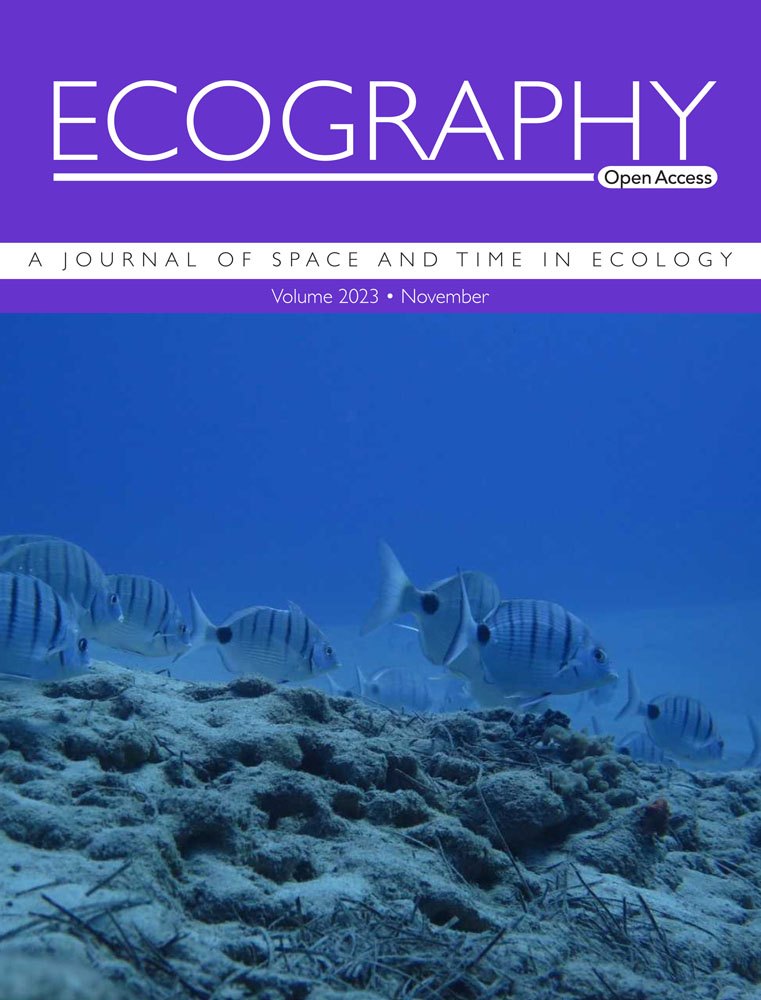Assembly processes inferred from eDNA surveys of a pond metacommunity are consistent with known species ecologies
IF 5.4
1区 环境科学与生态学
Q1 BIODIVERSITY CONSERVATION
引用次数: 0
Abstract
Technological advances are enabling ecologists to conduct large-scale and structured community surveys. However, it is unclear how best to extract information from these novel community data. We metabarcoded 48 vertebrate species from their eDNA in 320 ponds across England and applied the ‘internal structure' approach, which uses joint species distribution models (JSDMs) to explain compositions as the result of four metacommunity processes: environmental filtering, dispersal, species interactions, and stochasticity. We confirm that environmental filtering plays an important role in community assembly, and find that species' estimated environmental preferences are consistent with known ecologies. We also detect negative biotic covariances between fish and amphibians after controlling for divergent environmental preferences, consistent with predator–prey interactions (likely mediated by predator avoidance behaviour), and we detect high spatial autocorrelation for the palmate newt, consistent with its hypothesised relict distribution. Promisingly, ecologically and spatially distinctive sites are better explained by their environmental covariates and geographic locations, respectively, revealing sites where environmental filtering and dispersal limitation act more strongly. These results are consistent with the recent proposal that applying JSDMs to species distribution patterns can help reveal the relative importance of environmental filtering, dispersal limitation, and biotic interaction processes for individual sites and species. Our results also highlight the value of the modern interpretation of metacommunity ecology, which embraces the fact that assembly processes differ among species and sites. We discuss how novel community data allow for several study design improvements that will strengthen the inference of metacommunity assembly processes from observational data.从池塘元群落的eDNA调查中推断出的组装过程与已知的物种生态一致
技术进步使生态学家能够进行大规模和结构化的群落调查。然而,目前尚不清楚如何最好地从这些新的社区数据中提取信息。我们对来自英格兰320个池塘的48种脊椎动物的eDNA进行了元条形码编码,并应用了“内部结构”方法,该方法使用联合物种分布模型(JSDMs)来解释四种元群落过程的组成:环境过滤、扩散、物种相互作用和随机性。我们证实了环境过滤在群落聚集中起着重要作用,并发现物种估计的环境偏好与已知的生态是一致的。我们还发现,在控制了不同的环境偏好后,鱼类和两栖动物之间存在负的生物协方差,这与捕食者-猎物相互作用(可能由捕食者回避行为介导)相一致,我们发现掌螈的空间自相关性很高,与其假设的遗存分布相一致。有希望的是,生态和空间上独特的站点分别可以通过其环境协变量和地理位置来更好地解释,揭示环境过滤和扩散限制作用更强的站点。这些结果与最近提出的将JSDMs应用于物种分布模式有助于揭示环境过滤、扩散限制和生物相互作用过程对单个地点和物种的相对重要性的建议一致。我们的研究结果还强调了元群落生态学的现代解释的价值,它包含了物种和地点之间组装过程不同的事实。我们讨论了新的群落数据如何允许几个研究设计改进,这将加强从观测数据推断元群落组装过程。
本文章由计算机程序翻译,如有差异,请以英文原文为准。
求助全文
约1分钟内获得全文
求助全文
来源期刊

Ecography
环境科学-生态学
CiteScore
11.60
自引率
3.40%
发文量
122
审稿时长
8-16 weeks
期刊介绍:
ECOGRAPHY publishes exciting, novel, and important articles that significantly advance understanding of ecological or biodiversity patterns in space or time. Papers focusing on conservation or restoration are welcomed, provided they are anchored in ecological theory and convey a general message that goes beyond a single case study. We encourage papers that seek advancing the field through the development and testing of theory or methodology, or by proposing new tools for analysis or interpretation of ecological phenomena. Manuscripts are expected to address general principles in ecology, though they may do so using a specific model system if they adequately frame the problem relative to a generalized ecological question or problem.
Purely descriptive papers are considered only if breaking new ground and/or describing patterns seldom explored. Studies focused on a single species or single location are generally discouraged unless they make a significant contribution to advancing general theory or understanding of biodiversity patterns and processes. Manuscripts merely confirming or marginally extending results of previous work are unlikely to be considered in Ecography.
Papers are judged by virtue of their originality, appeal to general interest, and their contribution to new developments in studies of spatial and temporal ecological patterns. There are no biases with regard to taxon, biome, or biogeographical area.
 求助内容:
求助内容: 应助结果提醒方式:
应助结果提醒方式:


